Is Money the Key? Employee Motivation, Retention, and Attraction Essay
VerifiedAdded on 2023/01/16
|10
|2754
|51
Essay
AI Summary
This essay delves into the critical aspects of employee motivation, retention, and attraction within the realm of Human Resource Management. It addresses the central question of whether money holds the key to securing and maintaining a high-performing workforce. The essay begins with an introduction to the competitive landscape of contemporary businesses and the importance of retaining and motivating employees. It then explores various established theories, including Maslow's Need Hierarchy Theory, the Total Rewards Model, Herzberg's Motivation Hygiene Theory, Vroom's Expectancy Theory, and Job Embeddedness Theory. Each theory is examined in detail, with a focus on its relevance to the role of money in employee motivation. The analysis reveals that while money plays a role, particularly at the initial stages of an employee's career, other factors such as job satisfaction, work environment, opportunities for growth, and relationships with colleagues are also crucial. The essay concludes by synthesizing the insights from the different theories and providing a balanced perspective on the multifaceted nature of employee motivation and retention. The essay suggests that a comprehensive approach, going beyond monetary compensation, is essential for attracting, retaining, and motivating high-performing employees.
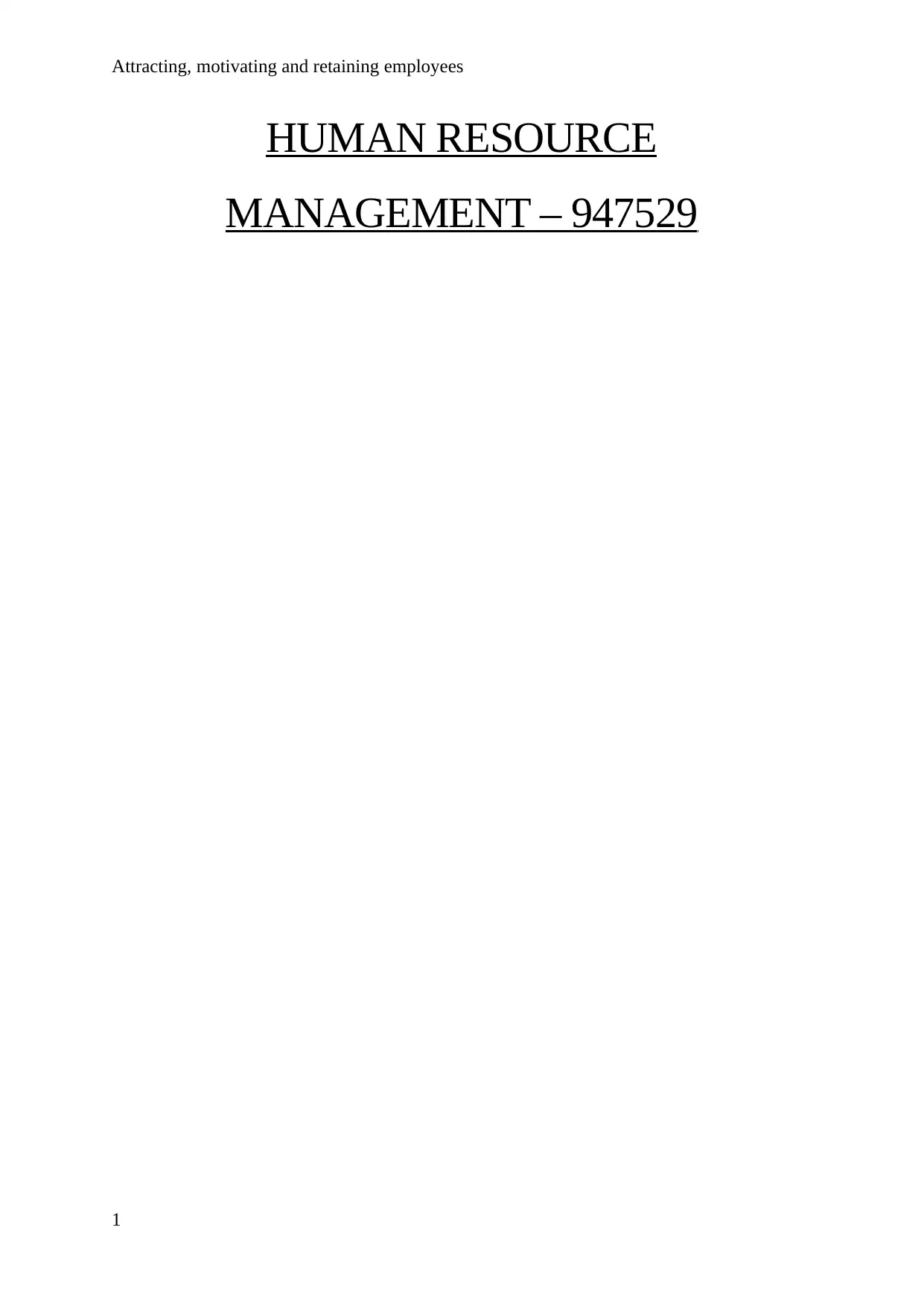
Attracting, motivating and retaining employees
HUMAN RESOURCE
MANAGEMENT – 947529
1
HUMAN RESOURCE
MANAGEMENT – 947529
1
Paraphrase This Document
Need a fresh take? Get an instant paraphrase of this document with our AI Paraphraser
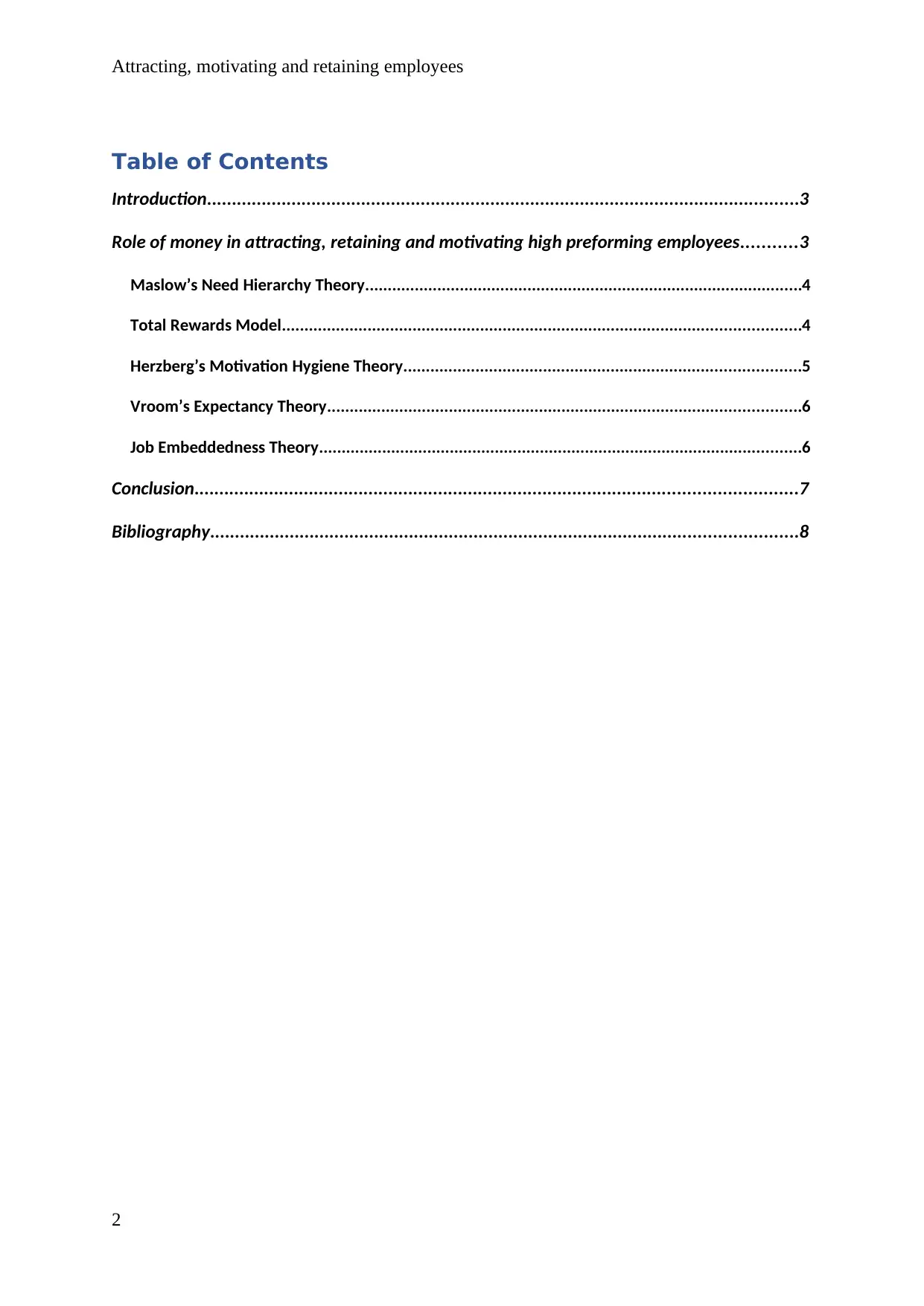
Attracting, motivating and retaining employees
Table of Contents
Introduction.......................................................................................................................3
Role of money in attracting, retaining and motivating high preforming employees...........3
Maslow’s Need Hierarchy Theory.................................................................................................4
Total Rewards Model...................................................................................................................4
Herzberg’s Motivation Hygiene Theory........................................................................................5
Vroom’s Expectancy Theory.........................................................................................................6
Job Embeddedness Theory...........................................................................................................6
Conclusion.........................................................................................................................7
Bibliography......................................................................................................................8
2
Table of Contents
Introduction.......................................................................................................................3
Role of money in attracting, retaining and motivating high preforming employees...........3
Maslow’s Need Hierarchy Theory.................................................................................................4
Total Rewards Model...................................................................................................................4
Herzberg’s Motivation Hygiene Theory........................................................................................5
Vroom’s Expectancy Theory.........................................................................................................6
Job Embeddedness Theory...........................................................................................................6
Conclusion.........................................................................................................................7
Bibliography......................................................................................................................8
2
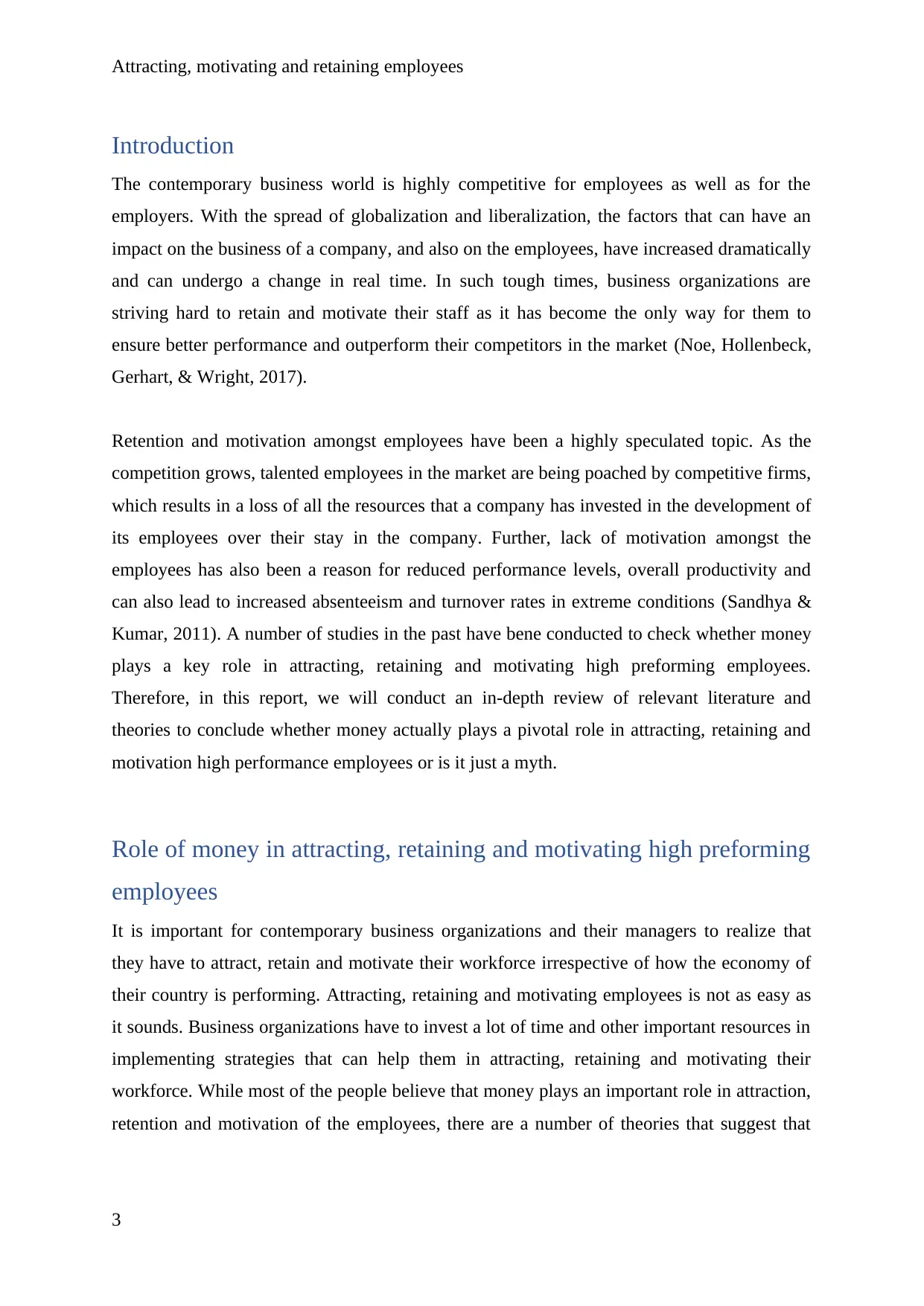
Attracting, motivating and retaining employees
Introduction
The contemporary business world is highly competitive for employees as well as for the
employers. With the spread of globalization and liberalization, the factors that can have an
impact on the business of a company, and also on the employees, have increased dramatically
and can undergo a change in real time. In such tough times, business organizations are
striving hard to retain and motivate their staff as it has become the only way for them to
ensure better performance and outperform their competitors in the market (Noe, Hollenbeck,
Gerhart, & Wright, 2017).
Retention and motivation amongst employees have been a highly speculated topic. As the
competition grows, talented employees in the market are being poached by competitive firms,
which results in a loss of all the resources that a company has invested in the development of
its employees over their stay in the company. Further, lack of motivation amongst the
employees has also been a reason for reduced performance levels, overall productivity and
can also lead to increased absenteeism and turnover rates in extreme conditions (Sandhya &
Kumar, 2011). A number of studies in the past have bene conducted to check whether money
plays a key role in attracting, retaining and motivating high preforming employees.
Therefore, in this report, we will conduct an in-depth review of relevant literature and
theories to conclude whether money actually plays a pivotal role in attracting, retaining and
motivation high performance employees or is it just a myth.
Role of money in attracting, retaining and motivating high preforming
employees
It is important for contemporary business organizations and their managers to realize that
they have to attract, retain and motivate their workforce irrespective of how the economy of
their country is performing. Attracting, retaining and motivating employees is not as easy as
it sounds. Business organizations have to invest a lot of time and other important resources in
implementing strategies that can help them in attracting, retaining and motivating their
workforce. While most of the people believe that money plays an important role in attraction,
retention and motivation of the employees, there are a number of theories that suggest that
3
Introduction
The contemporary business world is highly competitive for employees as well as for the
employers. With the spread of globalization and liberalization, the factors that can have an
impact on the business of a company, and also on the employees, have increased dramatically
and can undergo a change in real time. In such tough times, business organizations are
striving hard to retain and motivate their staff as it has become the only way for them to
ensure better performance and outperform their competitors in the market (Noe, Hollenbeck,
Gerhart, & Wright, 2017).
Retention and motivation amongst employees have been a highly speculated topic. As the
competition grows, talented employees in the market are being poached by competitive firms,
which results in a loss of all the resources that a company has invested in the development of
its employees over their stay in the company. Further, lack of motivation amongst the
employees has also been a reason for reduced performance levels, overall productivity and
can also lead to increased absenteeism and turnover rates in extreme conditions (Sandhya &
Kumar, 2011). A number of studies in the past have bene conducted to check whether money
plays a key role in attracting, retaining and motivating high preforming employees.
Therefore, in this report, we will conduct an in-depth review of relevant literature and
theories to conclude whether money actually plays a pivotal role in attracting, retaining and
motivation high performance employees or is it just a myth.
Role of money in attracting, retaining and motivating high preforming
employees
It is important for contemporary business organizations and their managers to realize that
they have to attract, retain and motivate their workforce irrespective of how the economy of
their country is performing. Attracting, retaining and motivating employees is not as easy as
it sounds. Business organizations have to invest a lot of time and other important resources in
implementing strategies that can help them in attracting, retaining and motivating their
workforce. While most of the people believe that money plays an important role in attraction,
retention and motivation of the employees, there are a number of theories that suggest that
3
⊘ This is a preview!⊘
Do you want full access?
Subscribe today to unlock all pages.

Trusted by 1+ million students worldwide
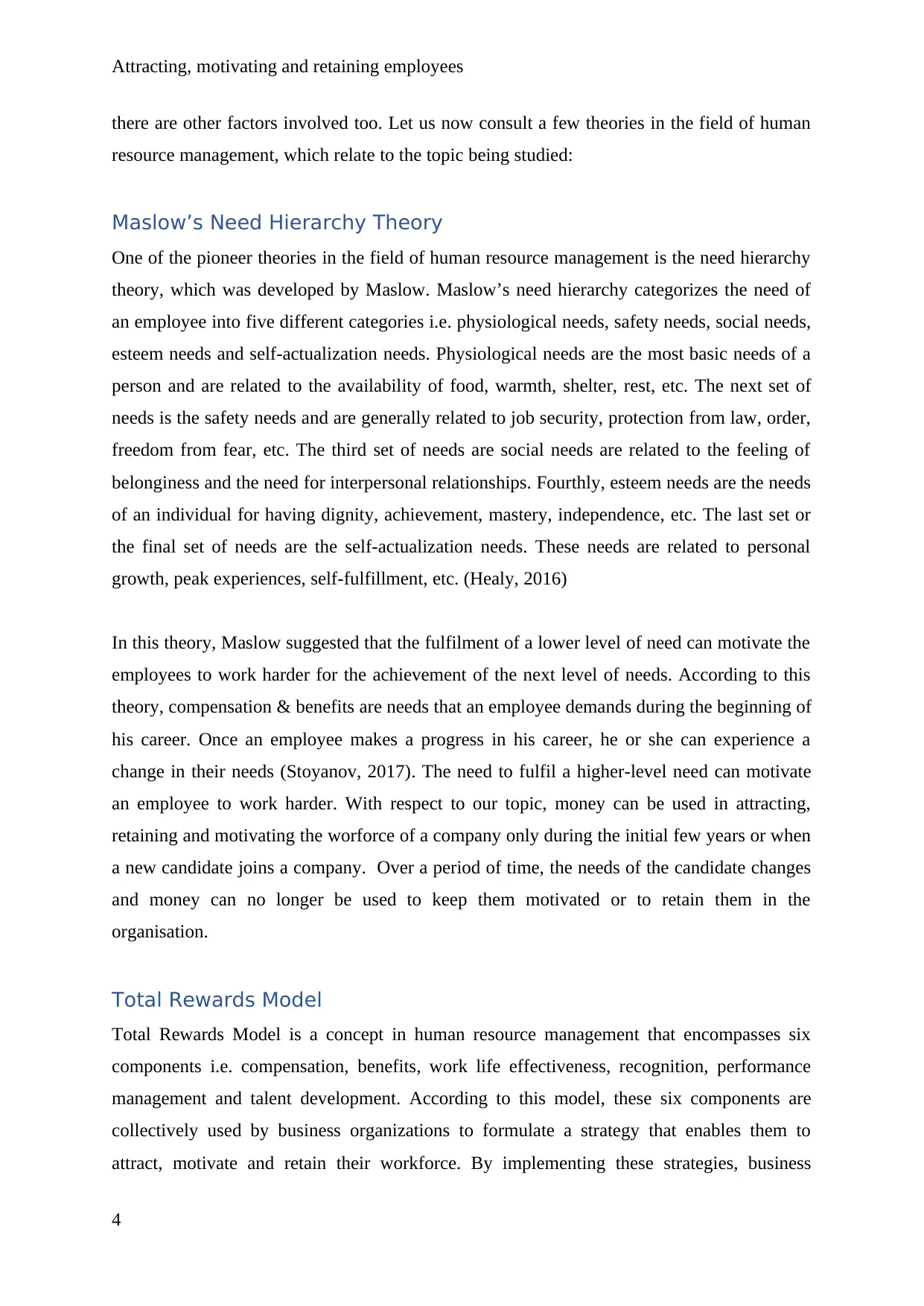
Attracting, motivating and retaining employees
there are other factors involved too. Let us now consult a few theories in the field of human
resource management, which relate to the topic being studied:
Maslow’s Need Hierarchy Theory
One of the pioneer theories in the field of human resource management is the need hierarchy
theory, which was developed by Maslow. Maslow’s need hierarchy categorizes the need of
an employee into five different categories i.e. physiological needs, safety needs, social needs,
esteem needs and self-actualization needs. Physiological needs are the most basic needs of a
person and are related to the availability of food, warmth, shelter, rest, etc. The next set of
needs is the safety needs and are generally related to job security, protection from law, order,
freedom from fear, etc. The third set of needs are social needs are related to the feeling of
belonginess and the need for interpersonal relationships. Fourthly, esteem needs are the needs
of an individual for having dignity, achievement, mastery, independence, etc. The last set or
the final set of needs are the self-actualization needs. These needs are related to personal
growth, peak experiences, self-fulfillment, etc. (Healy, 2016)
In this theory, Maslow suggested that the fulfilment of a lower level of need can motivate the
employees to work harder for the achievement of the next level of needs. According to this
theory, compensation & benefits are needs that an employee demands during the beginning of
his career. Once an employee makes a progress in his career, he or she can experience a
change in their needs (Stoyanov, 2017). The need to fulfil a higher-level need can motivate
an employee to work harder. With respect to our topic, money can be used in attracting,
retaining and motivating the worforce of a company only during the initial few years or when
a new candidate joins a company. Over a period of time, the needs of the candidate changes
and money can no longer be used to keep them motivated or to retain them in the
organisation.
Total Rewards Model
Total Rewards Model is a concept in human resource management that encompasses six
components i.e. compensation, benefits, work life effectiveness, recognition, performance
management and talent development. According to this model, these six components are
collectively used by business organizations to formulate a strategy that enables them to
attract, motivate and retain their workforce. By implementing these strategies, business
4
there are other factors involved too. Let us now consult a few theories in the field of human
resource management, which relate to the topic being studied:
Maslow’s Need Hierarchy Theory
One of the pioneer theories in the field of human resource management is the need hierarchy
theory, which was developed by Maslow. Maslow’s need hierarchy categorizes the need of
an employee into five different categories i.e. physiological needs, safety needs, social needs,
esteem needs and self-actualization needs. Physiological needs are the most basic needs of a
person and are related to the availability of food, warmth, shelter, rest, etc. The next set of
needs is the safety needs and are generally related to job security, protection from law, order,
freedom from fear, etc. The third set of needs are social needs are related to the feeling of
belonginess and the need for interpersonal relationships. Fourthly, esteem needs are the needs
of an individual for having dignity, achievement, mastery, independence, etc. The last set or
the final set of needs are the self-actualization needs. These needs are related to personal
growth, peak experiences, self-fulfillment, etc. (Healy, 2016)
In this theory, Maslow suggested that the fulfilment of a lower level of need can motivate the
employees to work harder for the achievement of the next level of needs. According to this
theory, compensation & benefits are needs that an employee demands during the beginning of
his career. Once an employee makes a progress in his career, he or she can experience a
change in their needs (Stoyanov, 2017). The need to fulfil a higher-level need can motivate
an employee to work harder. With respect to our topic, money can be used in attracting,
retaining and motivating the worforce of a company only during the initial few years or when
a new candidate joins a company. Over a period of time, the needs of the candidate changes
and money can no longer be used to keep them motivated or to retain them in the
organisation.
Total Rewards Model
Total Rewards Model is a concept in human resource management that encompasses six
components i.e. compensation, benefits, work life effectiveness, recognition, performance
management and talent development. According to this model, these six components are
collectively used by business organizations to formulate a strategy that enables them to
attract, motivate and retain their workforce. By implementing these strategies, business
4
Paraphrase This Document
Need a fresh take? Get an instant paraphrase of this document with our AI Paraphraser
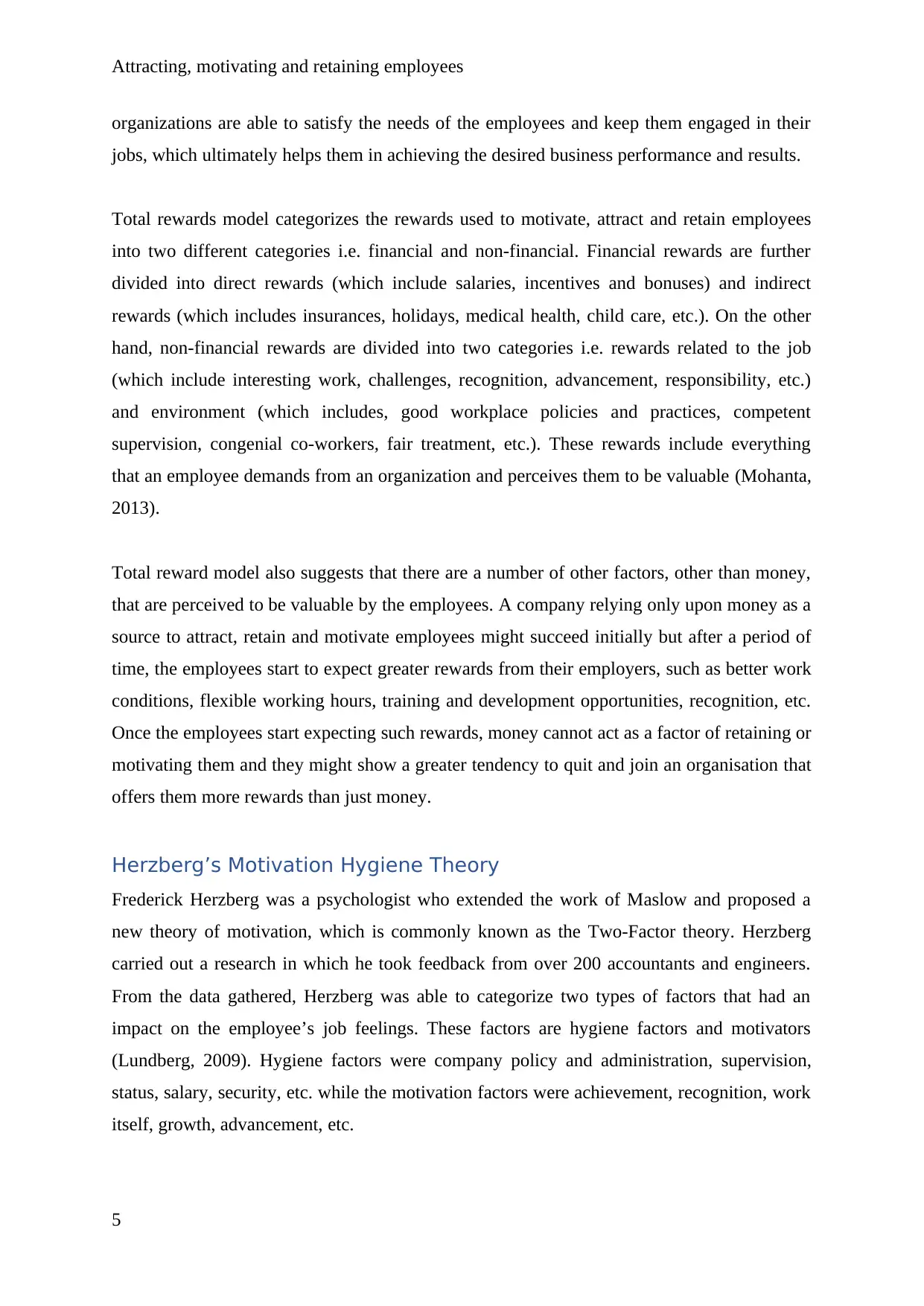
Attracting, motivating and retaining employees
organizations are able to satisfy the needs of the employees and keep them engaged in their
jobs, which ultimately helps them in achieving the desired business performance and results.
Total rewards model categorizes the rewards used to motivate, attract and retain employees
into two different categories i.e. financial and non-financial. Financial rewards are further
divided into direct rewards (which include salaries, incentives and bonuses) and indirect
rewards (which includes insurances, holidays, medical health, child care, etc.). On the other
hand, non-financial rewards are divided into two categories i.e. rewards related to the job
(which include interesting work, challenges, recognition, advancement, responsibility, etc.)
and environment (which includes, good workplace policies and practices, competent
supervision, congenial co-workers, fair treatment, etc.). These rewards include everything
that an employee demands from an organization and perceives them to be valuable (Mohanta,
2013).
Total reward model also suggests that there are a number of other factors, other than money,
that are perceived to be valuable by the employees. A company relying only upon money as a
source to attract, retain and motivate employees might succeed initially but after a period of
time, the employees start to expect greater rewards from their employers, such as better work
conditions, flexible working hours, training and development opportunities, recognition, etc.
Once the employees start expecting such rewards, money cannot act as a factor of retaining or
motivating them and they might show a greater tendency to quit and join an organisation that
offers them more rewards than just money.
Herzberg’s Motivation Hygiene Theory
Frederick Herzberg was a psychologist who extended the work of Maslow and proposed a
new theory of motivation, which is commonly known as the Two-Factor theory. Herzberg
carried out a research in which he took feedback from over 200 accountants and engineers.
From the data gathered, Herzberg was able to categorize two types of factors that had an
impact on the employee’s job feelings. These factors are hygiene factors and motivators
(Lundberg, 2009). Hygiene factors were company policy and administration, supervision,
status, salary, security, etc. while the motivation factors were achievement, recognition, work
itself, growth, advancement, etc.
5
organizations are able to satisfy the needs of the employees and keep them engaged in their
jobs, which ultimately helps them in achieving the desired business performance and results.
Total rewards model categorizes the rewards used to motivate, attract and retain employees
into two different categories i.e. financial and non-financial. Financial rewards are further
divided into direct rewards (which include salaries, incentives and bonuses) and indirect
rewards (which includes insurances, holidays, medical health, child care, etc.). On the other
hand, non-financial rewards are divided into two categories i.e. rewards related to the job
(which include interesting work, challenges, recognition, advancement, responsibility, etc.)
and environment (which includes, good workplace policies and practices, competent
supervision, congenial co-workers, fair treatment, etc.). These rewards include everything
that an employee demands from an organization and perceives them to be valuable (Mohanta,
2013).
Total reward model also suggests that there are a number of other factors, other than money,
that are perceived to be valuable by the employees. A company relying only upon money as a
source to attract, retain and motivate employees might succeed initially but after a period of
time, the employees start to expect greater rewards from their employers, such as better work
conditions, flexible working hours, training and development opportunities, recognition, etc.
Once the employees start expecting such rewards, money cannot act as a factor of retaining or
motivating them and they might show a greater tendency to quit and join an organisation that
offers them more rewards than just money.
Herzberg’s Motivation Hygiene Theory
Frederick Herzberg was a psychologist who extended the work of Maslow and proposed a
new theory of motivation, which is commonly known as the Two-Factor theory. Herzberg
carried out a research in which he took feedback from over 200 accountants and engineers.
From the data gathered, Herzberg was able to categorize two types of factors that had an
impact on the employee’s job feelings. These factors are hygiene factors and motivators
(Lundberg, 2009). Hygiene factors were company policy and administration, supervision,
status, salary, security, etc. while the motivation factors were achievement, recognition, work
itself, growth, advancement, etc.
5
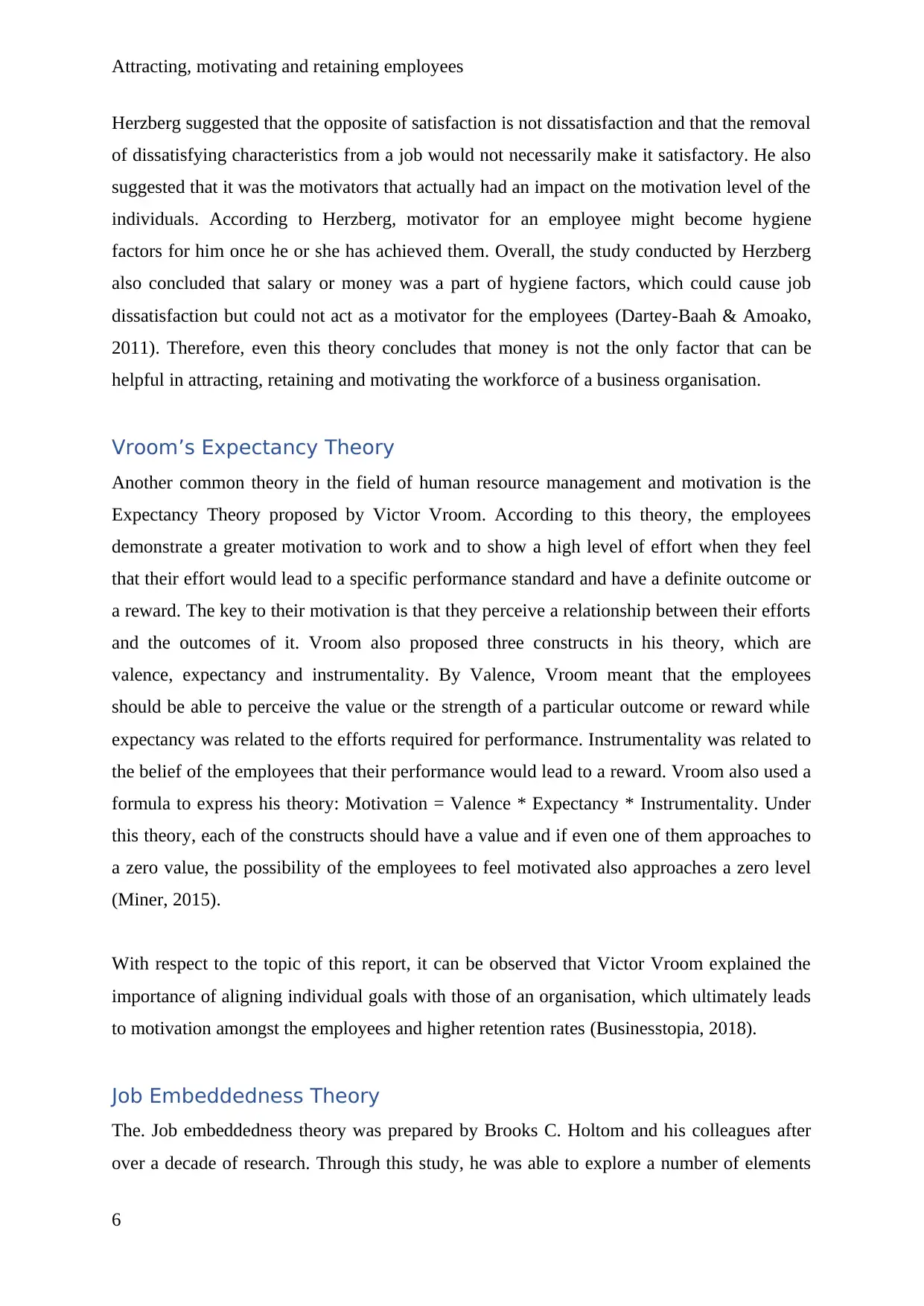
Attracting, motivating and retaining employees
Herzberg suggested that the opposite of satisfaction is not dissatisfaction and that the removal
of dissatisfying characteristics from a job would not necessarily make it satisfactory. He also
suggested that it was the motivators that actually had an impact on the motivation level of the
individuals. According to Herzberg, motivator for an employee might become hygiene
factors for him once he or she has achieved them. Overall, the study conducted by Herzberg
also concluded that salary or money was a part of hygiene factors, which could cause job
dissatisfaction but could not act as a motivator for the employees (Dartey-Baah & Amoako,
2011). Therefore, even this theory concludes that money is not the only factor that can be
helpful in attracting, retaining and motivating the workforce of a business organisation.
Vroom’s Expectancy Theory
Another common theory in the field of human resource management and motivation is the
Expectancy Theory proposed by Victor Vroom. According to this theory, the employees
demonstrate a greater motivation to work and to show a high level of effort when they feel
that their effort would lead to a specific performance standard and have a definite outcome or
a reward. The key to their motivation is that they perceive a relationship between their efforts
and the outcomes of it. Vroom also proposed three constructs in his theory, which are
valence, expectancy and instrumentality. By Valence, Vroom meant that the employees
should be able to perceive the value or the strength of a particular outcome or reward while
expectancy was related to the efforts required for performance. Instrumentality was related to
the belief of the employees that their performance would lead to a reward. Vroom also used a
formula to express his theory: Motivation = Valence * Expectancy * Instrumentality. Under
this theory, each of the constructs should have a value and if even one of them approaches to
a zero value, the possibility of the employees to feel motivated also approaches a zero level
(Miner, 2015).
With respect to the topic of this report, it can be observed that Victor Vroom explained the
importance of aligning individual goals with those of an organisation, which ultimately leads
to motivation amongst the employees and higher retention rates (Businesstopia, 2018).
Job Embeddedness Theory
The. Job embeddedness theory was prepared by Brooks C. Holtom and his colleagues after
over a decade of research. Through this study, he was able to explore a number of elements
6
Herzberg suggested that the opposite of satisfaction is not dissatisfaction and that the removal
of dissatisfying characteristics from a job would not necessarily make it satisfactory. He also
suggested that it was the motivators that actually had an impact on the motivation level of the
individuals. According to Herzberg, motivator for an employee might become hygiene
factors for him once he or she has achieved them. Overall, the study conducted by Herzberg
also concluded that salary or money was a part of hygiene factors, which could cause job
dissatisfaction but could not act as a motivator for the employees (Dartey-Baah & Amoako,
2011). Therefore, even this theory concludes that money is not the only factor that can be
helpful in attracting, retaining and motivating the workforce of a business organisation.
Vroom’s Expectancy Theory
Another common theory in the field of human resource management and motivation is the
Expectancy Theory proposed by Victor Vroom. According to this theory, the employees
demonstrate a greater motivation to work and to show a high level of effort when they feel
that their effort would lead to a specific performance standard and have a definite outcome or
a reward. The key to their motivation is that they perceive a relationship between their efforts
and the outcomes of it. Vroom also proposed three constructs in his theory, which are
valence, expectancy and instrumentality. By Valence, Vroom meant that the employees
should be able to perceive the value or the strength of a particular outcome or reward while
expectancy was related to the efforts required for performance. Instrumentality was related to
the belief of the employees that their performance would lead to a reward. Vroom also used a
formula to express his theory: Motivation = Valence * Expectancy * Instrumentality. Under
this theory, each of the constructs should have a value and if even one of them approaches to
a zero value, the possibility of the employees to feel motivated also approaches a zero level
(Miner, 2015).
With respect to the topic of this report, it can be observed that Victor Vroom explained the
importance of aligning individual goals with those of an organisation, which ultimately leads
to motivation amongst the employees and higher retention rates (Businesstopia, 2018).
Job Embeddedness Theory
The. Job embeddedness theory was prepared by Brooks C. Holtom and his colleagues after
over a decade of research. Through this study, he was able to explore a number of elements
6
⊘ This is a preview!⊘
Do you want full access?
Subscribe today to unlock all pages.

Trusted by 1+ million students worldwide
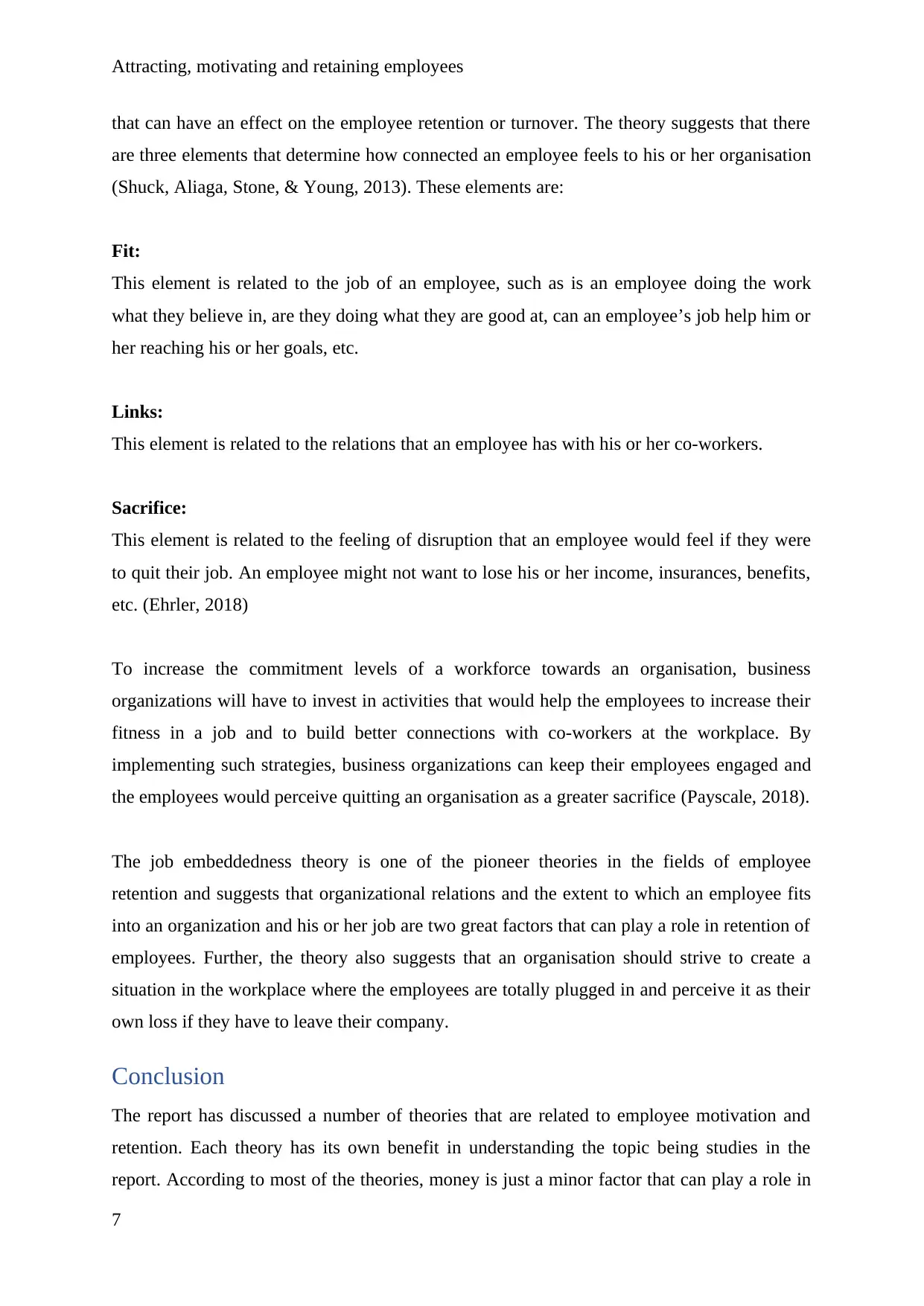
Attracting, motivating and retaining employees
that can have an effect on the employee retention or turnover. The theory suggests that there
are three elements that determine how connected an employee feels to his or her organisation
(Shuck, Aliaga, Stone, & Young, 2013). These elements are:
Fit:
This element is related to the job of an employee, such as is an employee doing the work
what they believe in, are they doing what they are good at, can an employee’s job help him or
her reaching his or her goals, etc.
Links:
This element is related to the relations that an employee has with his or her co-workers.
Sacrifice:
This element is related to the feeling of disruption that an employee would feel if they were
to quit their job. An employee might not want to lose his or her income, insurances, benefits,
etc. (Ehrler, 2018)
To increase the commitment levels of a workforce towards an organisation, business
organizations will have to invest in activities that would help the employees to increase their
fitness in a job and to build better connections with co-workers at the workplace. By
implementing such strategies, business organizations can keep their employees engaged and
the employees would perceive quitting an organisation as a greater sacrifice (Payscale, 2018).
The job embeddedness theory is one of the pioneer theories in the fields of employee
retention and suggests that organizational relations and the extent to which an employee fits
into an organization and his or her job are two great factors that can play a role in retention of
employees. Further, the theory also suggests that an organisation should strive to create a
situation in the workplace where the employees are totally plugged in and perceive it as their
own loss if they have to leave their company.
Conclusion
The report has discussed a number of theories that are related to employee motivation and
retention. Each theory has its own benefit in understanding the topic being studies in the
report. According to most of the theories, money is just a minor factor that can play a role in
7
that can have an effect on the employee retention or turnover. The theory suggests that there
are three elements that determine how connected an employee feels to his or her organisation
(Shuck, Aliaga, Stone, & Young, 2013). These elements are:
Fit:
This element is related to the job of an employee, such as is an employee doing the work
what they believe in, are they doing what they are good at, can an employee’s job help him or
her reaching his or her goals, etc.
Links:
This element is related to the relations that an employee has with his or her co-workers.
Sacrifice:
This element is related to the feeling of disruption that an employee would feel if they were
to quit their job. An employee might not want to lose his or her income, insurances, benefits,
etc. (Ehrler, 2018)
To increase the commitment levels of a workforce towards an organisation, business
organizations will have to invest in activities that would help the employees to increase their
fitness in a job and to build better connections with co-workers at the workplace. By
implementing such strategies, business organizations can keep their employees engaged and
the employees would perceive quitting an organisation as a greater sacrifice (Payscale, 2018).
The job embeddedness theory is one of the pioneer theories in the fields of employee
retention and suggests that organizational relations and the extent to which an employee fits
into an organization and his or her job are two great factors that can play a role in retention of
employees. Further, the theory also suggests that an organisation should strive to create a
situation in the workplace where the employees are totally plugged in and perceive it as their
own loss if they have to leave their company.
Conclusion
The report has discussed a number of theories that are related to employee motivation and
retention. Each theory has its own benefit in understanding the topic being studies in the
report. According to most of the theories, money is just a minor factor that can play a role in
7
Paraphrase This Document
Need a fresh take? Get an instant paraphrase of this document with our AI Paraphraser
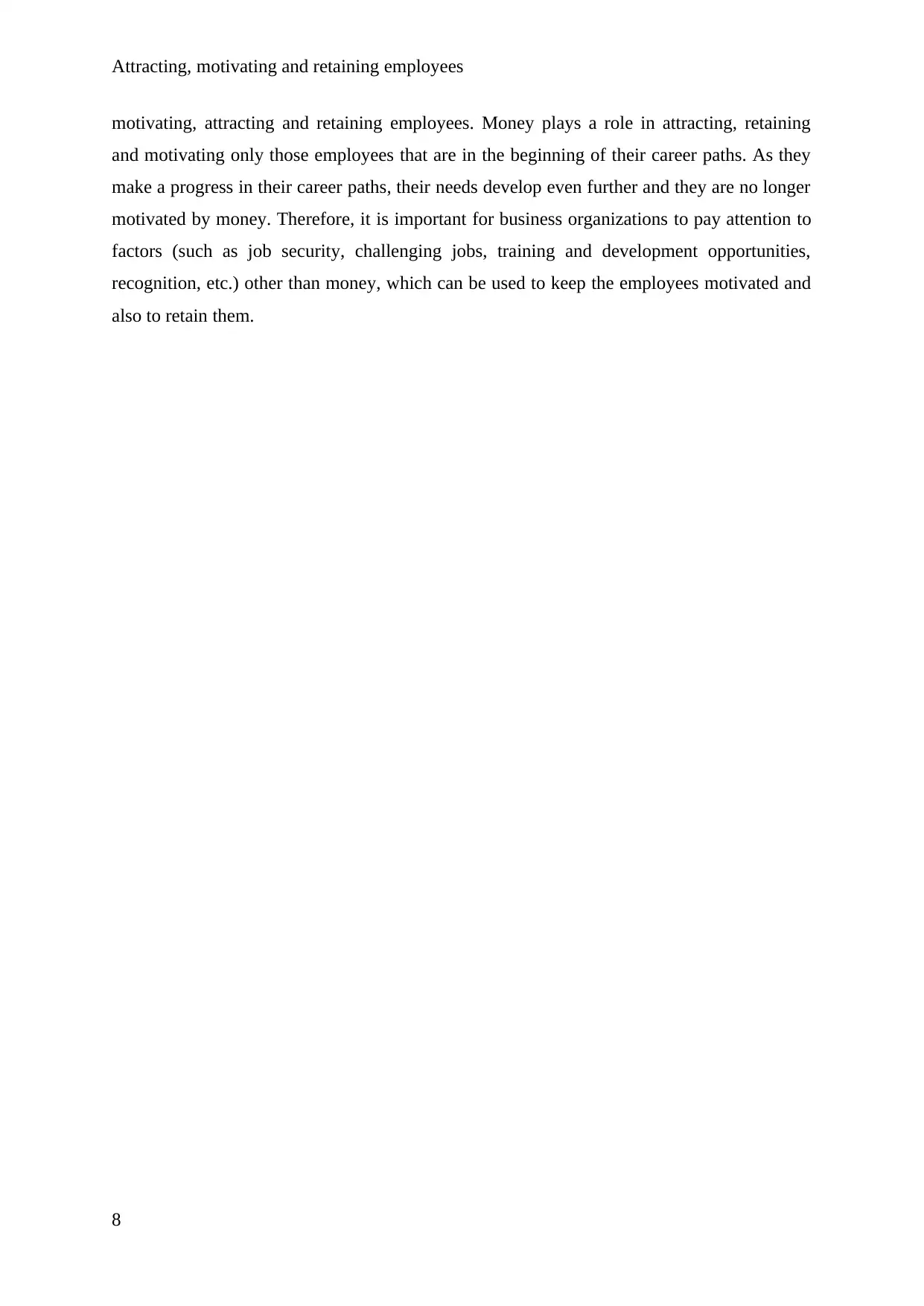
Attracting, motivating and retaining employees
motivating, attracting and retaining employees. Money plays a role in attracting, retaining
and motivating only those employees that are in the beginning of their career paths. As they
make a progress in their career paths, their needs develop even further and they are no longer
motivated by money. Therefore, it is important for business organizations to pay attention to
factors (such as job security, challenging jobs, training and development opportunities,
recognition, etc.) other than money, which can be used to keep the employees motivated and
also to retain them.
8
motivating, attracting and retaining employees. Money plays a role in attracting, retaining
and motivating only those employees that are in the beginning of their career paths. As they
make a progress in their career paths, their needs develop even further and they are no longer
motivated by money. Therefore, it is important for business organizations to pay attention to
factors (such as job security, challenging jobs, training and development opportunities,
recognition, etc.) other than money, which can be used to keep the employees motivated and
also to retain them.
8
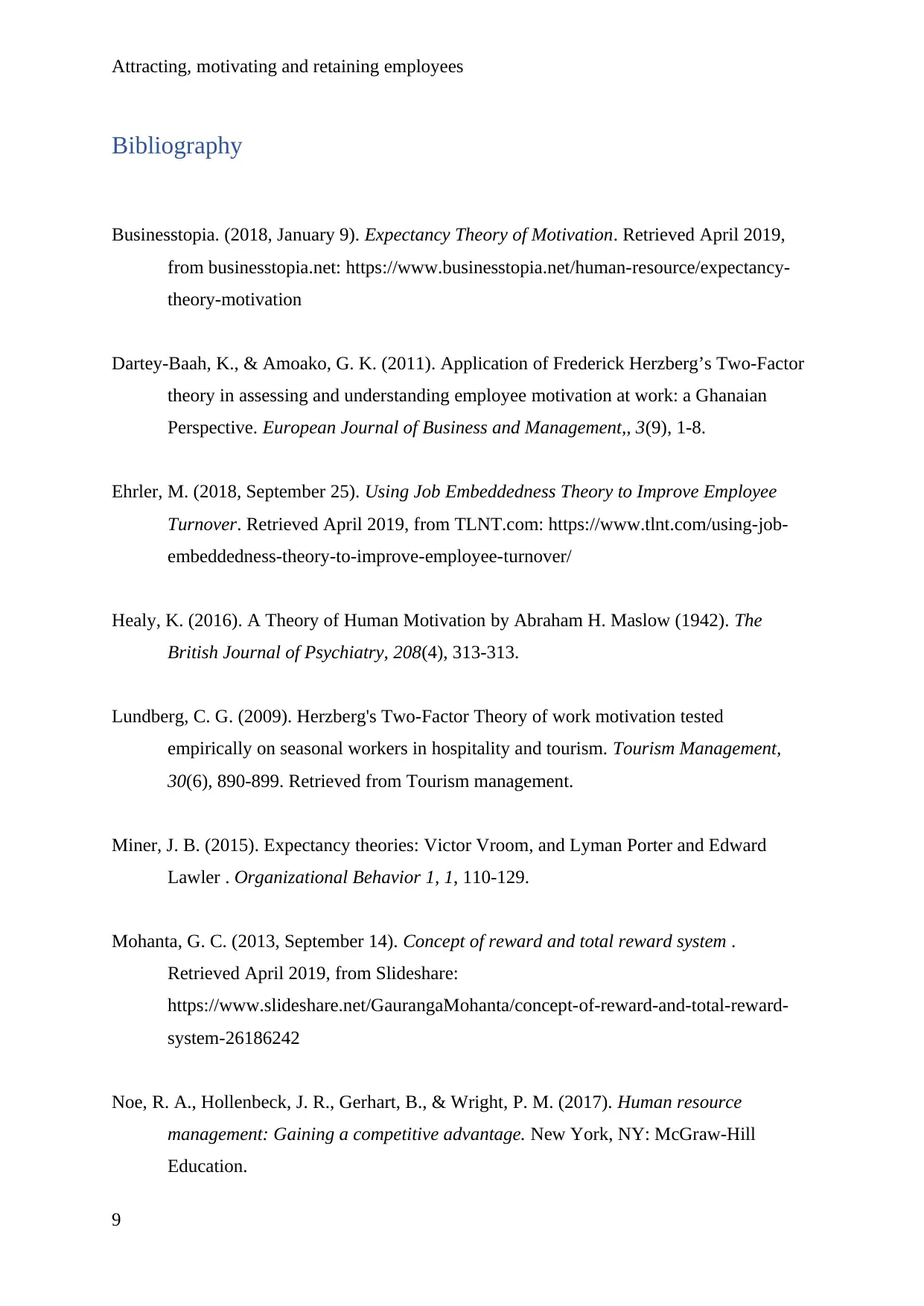
Attracting, motivating and retaining employees
Bibliography
Businesstopia. (2018, January 9). Expectancy Theory of Motivation. Retrieved April 2019,
from businesstopia.net: https://www.businesstopia.net/human-resource/expectancy-
theory-motivation
Dartey-Baah, K., & Amoako, G. K. (2011). Application of Frederick Herzberg’s Two-Factor
theory in assessing and understanding employee motivation at work: a Ghanaian
Perspective. European Journal of Business and Management,, 3(9), 1-8.
Ehrler, M. (2018, September 25). Using Job Embeddedness Theory to Improve Employee
Turnover. Retrieved April 2019, from TLNT.com: https://www.tlnt.com/using-job-
embeddedness-theory-to-improve-employee-turnover/
Healy, K. (2016). A Theory of Human Motivation by Abraham H. Maslow (1942). The
British Journal of Psychiatry, 208(4), 313-313.
Lundberg, C. G. (2009). Herzberg's Two-Factor Theory of work motivation tested
empirically on seasonal workers in hospitality and tourism. Tourism Management,
30(6), 890-899. Retrieved from Tourism management.
Miner, J. B. (2015). Expectancy theories: Victor Vroom, and Lyman Porter and Edward
Lawler . Organizational Behavior 1, 1, 110-129.
Mohanta, G. C. (2013, September 14). Concept of reward and total reward system .
Retrieved April 2019, from Slideshare:
https://www.slideshare.net/GaurangaMohanta/concept-of-reward-and-total-reward-
system-26186242
Noe, R. A., Hollenbeck, J. R., Gerhart, B., & Wright, P. M. (2017). Human resource
management: Gaining a competitive advantage. New York, NY: McGraw-Hill
Education.
9
Bibliography
Businesstopia. (2018, January 9). Expectancy Theory of Motivation. Retrieved April 2019,
from businesstopia.net: https://www.businesstopia.net/human-resource/expectancy-
theory-motivation
Dartey-Baah, K., & Amoako, G. K. (2011). Application of Frederick Herzberg’s Two-Factor
theory in assessing and understanding employee motivation at work: a Ghanaian
Perspective. European Journal of Business and Management,, 3(9), 1-8.
Ehrler, M. (2018, September 25). Using Job Embeddedness Theory to Improve Employee
Turnover. Retrieved April 2019, from TLNT.com: https://www.tlnt.com/using-job-
embeddedness-theory-to-improve-employee-turnover/
Healy, K. (2016). A Theory of Human Motivation by Abraham H. Maslow (1942). The
British Journal of Psychiatry, 208(4), 313-313.
Lundberg, C. G. (2009). Herzberg's Two-Factor Theory of work motivation tested
empirically on seasonal workers in hospitality and tourism. Tourism Management,
30(6), 890-899. Retrieved from Tourism management.
Miner, J. B. (2015). Expectancy theories: Victor Vroom, and Lyman Porter and Edward
Lawler . Organizational Behavior 1, 1, 110-129.
Mohanta, G. C. (2013, September 14). Concept of reward and total reward system .
Retrieved April 2019, from Slideshare:
https://www.slideshare.net/GaurangaMohanta/concept-of-reward-and-total-reward-
system-26186242
Noe, R. A., Hollenbeck, J. R., Gerhart, B., & Wright, P. M. (2017). Human resource
management: Gaining a competitive advantage. New York, NY: McGraw-Hill
Education.
9
⊘ This is a preview!⊘
Do you want full access?
Subscribe today to unlock all pages.

Trusted by 1+ million students worldwide
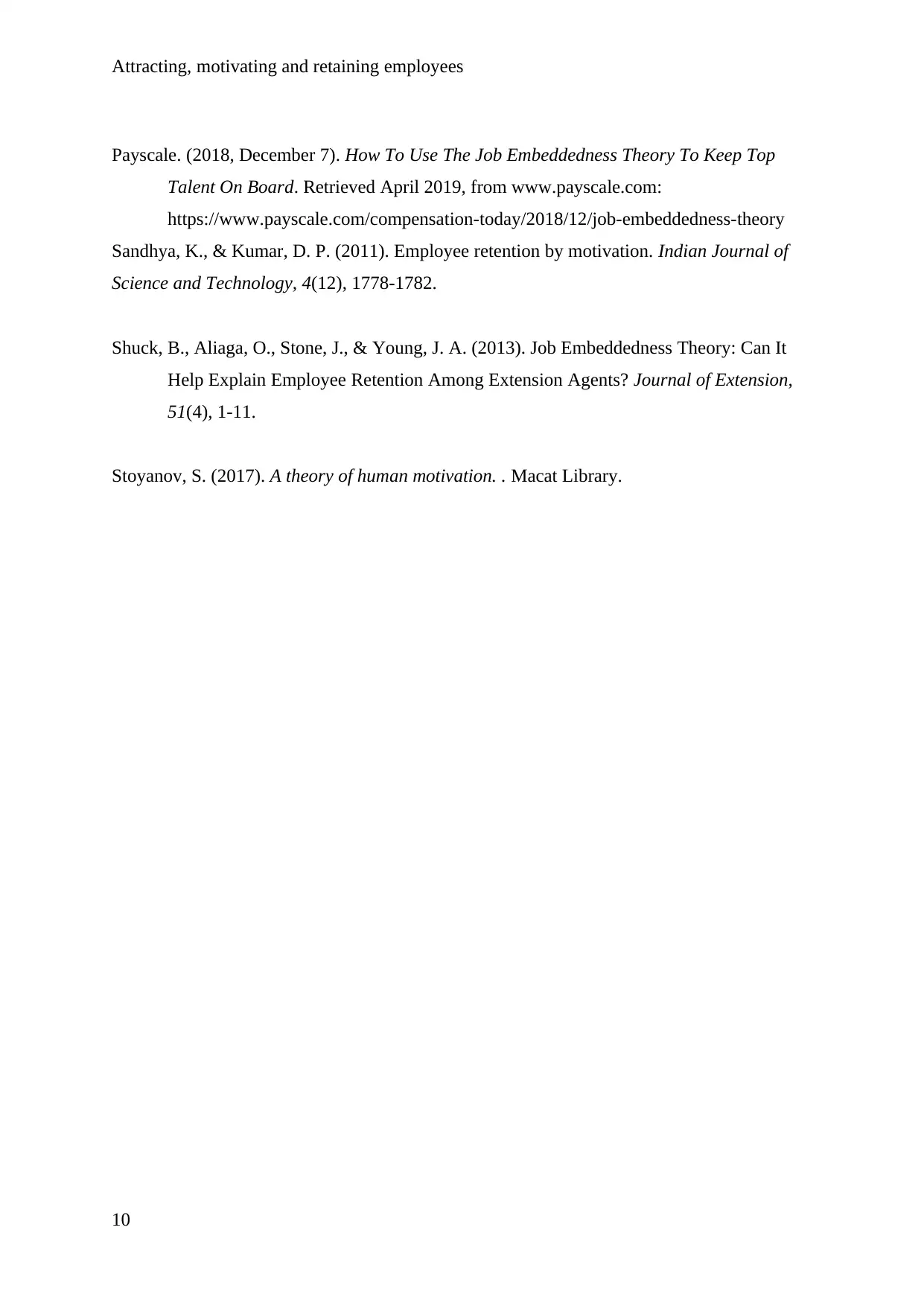
Attracting, motivating and retaining employees
Payscale. (2018, December 7). How To Use The Job Embeddedness Theory To Keep Top
Talent On Board. Retrieved April 2019, from www.payscale.com:
https://www.payscale.com/compensation-today/2018/12/job-embeddedness-theory
Sandhya, K., & Kumar, D. P. (2011). Employee retention by motivation. Indian Journal of
Science and Technology, 4(12), 1778-1782.
Shuck, B., Aliaga, O., Stone, J., & Young, J. A. (2013). Job Embeddedness Theory: Can It
Help Explain Employee Retention Among Extension Agents? Journal of Extension,
51(4), 1-11.
Stoyanov, S. (2017). A theory of human motivation. . Macat Library.
10
Payscale. (2018, December 7). How To Use The Job Embeddedness Theory To Keep Top
Talent On Board. Retrieved April 2019, from www.payscale.com:
https://www.payscale.com/compensation-today/2018/12/job-embeddedness-theory
Sandhya, K., & Kumar, D. P. (2011). Employee retention by motivation. Indian Journal of
Science and Technology, 4(12), 1778-1782.
Shuck, B., Aliaga, O., Stone, J., & Young, J. A. (2013). Job Embeddedness Theory: Can It
Help Explain Employee Retention Among Extension Agents? Journal of Extension,
51(4), 1-11.
Stoyanov, S. (2017). A theory of human motivation. . Macat Library.
10
1 out of 10
Related Documents
Your All-in-One AI-Powered Toolkit for Academic Success.
+13062052269
info@desklib.com
Available 24*7 on WhatsApp / Email
![[object Object]](/_next/static/media/star-bottom.7253800d.svg)
Unlock your academic potential
Copyright © 2020–2025 A2Z Services. All Rights Reserved. Developed and managed by ZUCOL.





